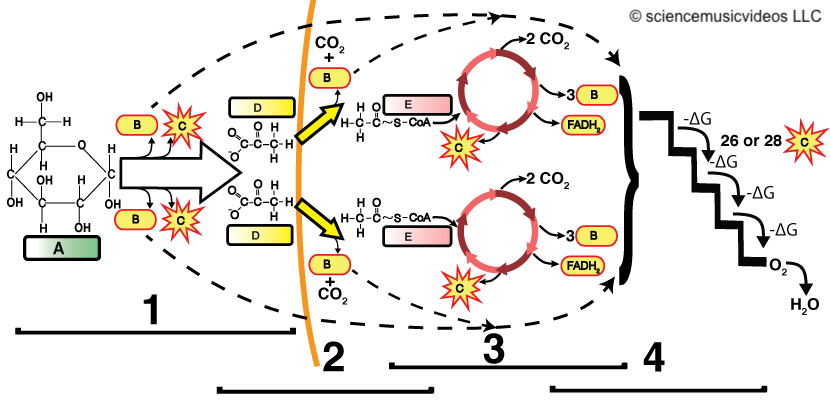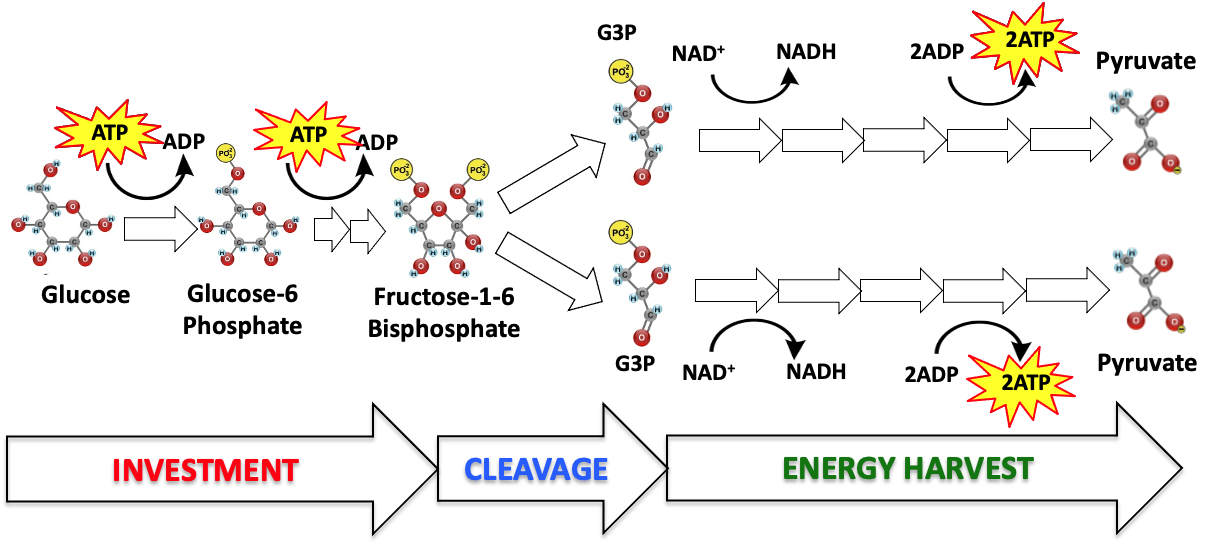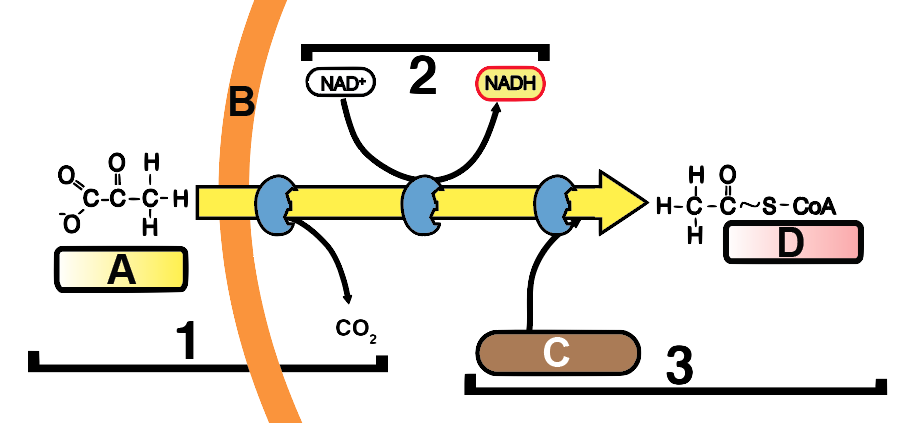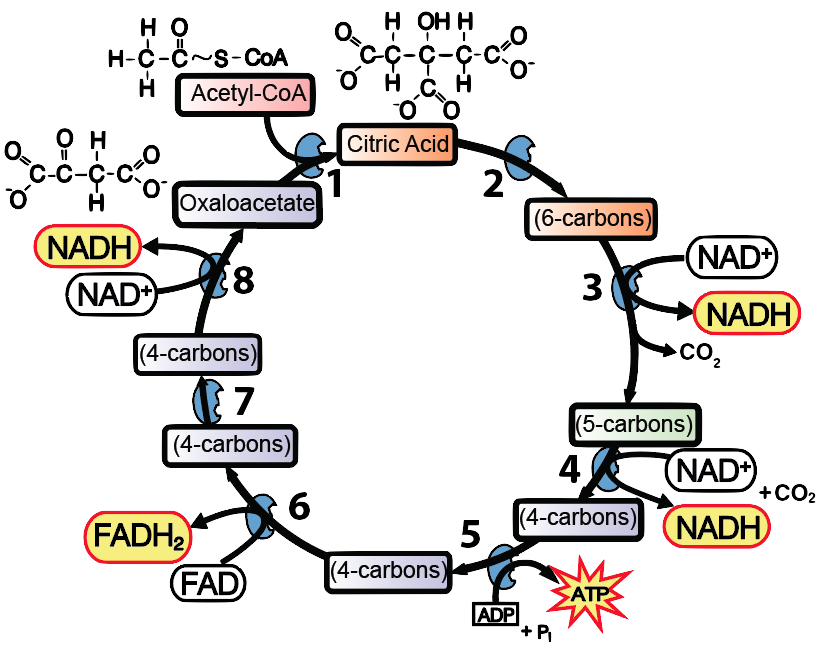1. Watch these Videos
1.a. Glycolysis, Link Reaction, and Krebs: ALL YOU NEED TO KNOW
1.b. Glycolysis Rap
2. Study this Summary
This tutorial covers the first 3 phases of cellular respiration: 1, 2, and 3 below.

1-glycolysis; 2-link reaction; 3-Krebs cycle; 4-Electron Transport Chain/Chemiosmosis;
A-glucose; B-ATP; C-NADH; D-pyruvate; E-acetyl-CoA
Glycolysis

Glycolysis
- Location & Nature:
- Occurs in the cytoplasm
- Anaerobic (does not require oxygen).
- Phases:
- Investment Phase: Glucose is phosphorylated using ATP, forming fructose-1,6-bisphosphate.
- Cleavage Phase: Fructose-1,6-bisphosphate splits into two molecules of G3P (glyceraldehyde-3-phosphate).
- Energy Harvest Phase:
- G3P is oxidized, transferring electrons to NAD+, forming NADH.
- ATP is generated via substrate-level phosphorylation (4 gross ATP; net gain is 2 ATP after accounting for 2 ATP used in investment).
- Outputs (per Glucose): 2 ATP, 2 NADH, and 2 pyruvate molecules.
Link Reaction

A-pyruvic acid; B-mitochondrial inner and outer membranes; C-Coenzyme-A; D-Acetyl-CoA; 1-decarboxylation (removing a CO₂); 2-oxidation of intermediate compound/reduction of NAD⁺ to NADH; 3-synthesis of Acetyl-CoA
- Process: Connects glycolysis to the Krebs cycle and occurs in the mitochondrial matrix.
- Steps:
- Pyruvate is transported into the mitochondria.
- Enzymes remove CO₂ from pyruvate (one-third of exhaled CO₂).
- The remaining 2-carbon molecule is oxidized, reducing NAD+ to NADH.
- The acetyl group attaches to coenzyme A, forming acetyl-CoA, the starting molecule for the Krebs cycle.
- Outputs (per pyruvate): one NADH
- Waste product: one CO₂.
Krebs Cycle (Citric Acid or TCA Cycle)

- Location: Mitochondrial matrix.
- Overview: A cyclic series of reactions that oxidize acetyl-CoA, producing electron carriers and releasing CO₂.
- Five things you need to know about the Kreb Cycle for AP Bio: Refer to the diagram above.
- 1: Acetyl-CoA combines with oxaloacetate to form citrate (1 above)
- 2: Citrate and its byproducts undergo oxidation, transferring electrons to NAD+ (forming NADH) and FAD (forming FADH₂). This is shown at 3, 4, 6, and 8 above
- 3. One ATP is generated through a substrate-level phosphorylation (5 above)
- 4. CO₂ is released as a byproduct (two-thirds of exhaled CO₂). Shown at 3 and 4 above
- 5. Oxaloacetate is regenerated to continue the cycle (1 above)
- Outputs (per acetyl-CoA): 1 ATP, 3 NADH, 1 FADH₂
- Waste product: 2 CO₂.
3. Master these Flashcards
[qdeck style=”width: 600px !important; min-height: 450px !important;” bold_text=”false” random=”true” qrecord_id=”sciencemusicvideosMeister1961-Glycolysis, Krebs, and Link Reaction Flashcards, APBVP”]
[h] Glycolysis, the Link Reaction, and the Krebs Cycle
[i]
[q json=”true” yy=”4″ unit=”3.Cellular_Energetics” dataset_id=”AP_Bio_Flashcards_2022|1f7c0a5dfc910″ question_number=”135″ topic=”3.6.Cellular_Respiration”] In terms of ATP, what are the net outputs of glycolysis, and how do they compare to the gross outputs?
[a] The gross output of glycolysis is 4 ATP, but the net yield is 2 ATP because 2 ATP are used in the investment phase. Additionally, glycolysis produces 2 NADH and 2 molecules of pyruvate.
[q json=”true” yy=”4″ unit=”3.Cellular_Energetics” dataset_id=”AP_Bio_Flashcards_2022|1f8c1b6dfc910″ question_number=”136″ topic=”3.6.Cellular_Respiration”] What happens during the energy harvest phase of glycolysis?
[a] During the energy harvest phase, enzymes oxidize G3P, transferring electrons to NAD+ to form NADH. Other enzymes use the chemical energy in G3P to perform substrate-level phosphorylation, generating ATP from ADP and phosphate. This phase produces 4 ATP (gross) and 2 NADH.
[q json=”true” yy=”4″ unit=”3.Cellular_Energetics” dataset_id=”AP_Bio_Flashcards_2022|1f9c2b7dfc910″ question_number=”137″ topic=”3.6.Cellular_Respiration”] Why is the Krebs cycle also called the tricarboxylic acid (TCA) cycle?
[a] The Krebs cycle is called the tricarboxylic acid cycle because citric acid, a key compound in Krebs, has three carboxylic acid groups.
[q json=”true” yy=”4″ unit=”3.Cellular_Energetics” dataset_id=”AP_Bio_Flashcards_2022|1fac3b8dfc910″ question_number=”138″ topic=”3.6.Cellular_Respiration”] How is carbon dioxide produced and released during cellular respiration?
[a] Carbon dioxide is produced
- During the link reaction when a CO2 molecule is removed from pyruvate
- During the Krebs cycle as intermediate compounds are oxidized, releasing two CO2 for each acetyl-CoA that enters the cycle.
These processes account for all the CO2 that is exhaled by animals during cellular respiration.
[q json=”true” yy=”4″ unit=”3.Cellular_Energetics” dataset_id=”AP_Bio_Flashcards_2022|1fbc4b9dfc910″ question_number=”139″ topic=”3.6.Cellular_Respiration”] What are the roles of NADH and FADH2 in cellular respiration?
[a] NADH and FADH2 are electron carriers that transport high-energy electrons to the electron transport chain. Their oxidation powers the production of ATP through chemiosmosis.
[q json=”true” yy=”4″ unit=”3.Cellular_Energetics” dataset_id=”AP_Bio_Flashcards_2022|1c30c15dfc910″ question_number=”124″ topic=”3.6.Cellular_Respiration”] When oxygen is present, cellular respiration happens in four phases. List each one, and describe its location.
[a]
Glycolysis occurs in the cytoplasm (3). The link reaction happens as pyruvic acid diffuses into the mitochondria (4). The Krebs cycle occurs in the mitochondrial matrix (5). The electron transport chain occurs along the inner mitochondrial membrane (6).
[q json=”true” yy=”4″ unit=”3.Cellular_Energetics” dataset_id=”AP_Bio_Flashcards_2022|1c019b6d33910″ question_number=”128″ topic=”3.6.Cellular_Respiration”] What happens during glycolysis? Include cellular locations, inputs, and outputs in your answer.
[a] The starting substrate is glucose. In a series of enzyme-catalyzed reactions, glucose is phosphorylated (investment phase), then split into two molecules of G3P (cleavage phase). Then G3P is oxidized, which provides the electrons needed to reduce NAD+ to NADH. Other enzymes use the chemical energy in G3P to power a substrate-level phosphorylation of two ATPs from ADP and Pi. The net yield of glycolysis is 2 ATPs and 2 NADH. The process ends with two molecules of the 3-carbon molecule pyruvate (also known as pyruvic acid).
[q json=”true” yy=”4″ unit=”3.Cellular_Energetics” topic=”3.6.Cellular_Respiration” dataset_id=”AP_Bio_Flashcards_2022|2184a813c2e64c” question_number=”129″] Glycolysis occurs in 3 phases. What are they?
[a] Investment, cleavage, and energy harvest.
[q json=”true” yy=”4″ unit=”3.Cellular_Energetics” dataset_id=”AP_Bio_Flashcards_2022|1beac2b886510″ question_number=”131″ topic=”3.6.Cellular_Respiration”] What happens between glycolysis and the Krebs cycle?
[a] During the link reaction, pyruvic acid (from glycolysis, at A) is transported across the outer and inner mitochondrial membranes (B) into the mitochondrial matrix. In the matrix, an enzyme removes a carbon dioxide. Other enzymes oxidize the resulting two-carbon molecule, powering the reduction of NAD+ to NADH (2). The two-carbon acetyl group that results is attached to coenzyme A, generating Acetyl-CoA (at “D”), the starting point for the Krebs cycle.
[q json=”true” yy=”4″ unit=”3.Cellular_Energetics” dataset_id=”AP_Bio_Flashcards_2022|1bdcefb1ec910″ question_number=”132″ topic=”3.6.Cellular_Respiration”] What comes into the Krebs Cycle? What comes out? What are these products used for?
[a] During the Krebs cycle, energy from food, brought into the cycle in the form of acetyl-CoA, is used to generate ATP from ADP and inorganic phosphate, and to chemically reduce the electron carriers NAD+ and FADH to NADH and FADH2. These electron carriers will later power the electron transport chain’s conversion of ADP and inorganic phosphate to ATP through chemiosmosis.
[q json=”true” yy=”4″ unit=”3.Cellular_Energetics” dataset_id=”AP_Bio_Flashcards_2022|1bcfd6ef0a110″ question_number=”133″ topic=”3.6.Cellular_Respiration”] Describe the Krebs cycle.
[a] The cycle starts as enzymes (at 1) transfer the two-carbon acetyl group from Acetyl-CoA to oxalic acid, a four-carbon molecule. This creates six-carbon citric acid. In subsequent reactions, citric acid is oxidized, and its electrons are used to reduce the electron carriers NAD+ and FADH to NADH and FADH2. Other reactions power the substrate-level phosphorylation of ADP and Pi into ATP.
For each acetyl-CoA that enters the cycle, one ATP, one FADH2, and three NADHs are generated. As this occurs, carbon dioxide is released as a waste product (accounting for 2/3 of the CO2 produced during cellular respiration).
[x] [restart]
[/qdeck]
4. Tackle these Quizzes
4.1 Glycolysis, Checking Understanding
[qwiz random=”true” qrecord_id=”sciencemusicvideosMeister1961-Glycolysis, APBVP”]
[h]Glycolysis: Checking Understanding
[i]
[q]Which letter or number indicates the “investment” phase?
[textentry single_char=”true”]
[c]ID E=[Qq]
[f]IFllcywg4oCcMeKAnSBpcyB0aGUgaW52ZXN0bWVudCBwaGFzZS4=[Qq]
[c]Kg==[Qq]
[f]Tm8uIEhlcmUmIzgyMTc7cyBhIGhpbnQuwqBUaGUgaW52ZXN0bWVudCBwaGFzZSBpcyB3aGVuIGVuZXJneSBpcyB1c2VkIGJ5IHRoZSBjZWxsLiBBIHR5cGljYWwgd2F5IHRoaW5nIHRoYXQgaGFwcGVucyB3aGVuIGNlbGxzIHVzZSBlbmVyZ3kgaXMgdGhhdCBBVFAgZ2V0cyBjb252ZXJ0ZWQgdG8gQURQLiBXaGVyZSBkbyB5b3Ugc2VlIHRoaXMgaGFwcGVuaW5nPw==
Cg==[Qq]
[q]Which letter or number indicates the “cleavage” phase?
[textentry single_char=”true”]
[c]wq Ay[Qq]
[f]IFllcywg4oCcMuKAnSBpcyB0aGUgY2xlYXZhZ2XCoHBoYXNlLg==[Qq]
[c]Kg==[Qq]
[f]Tm8uIEhlcmUmIzgyMTc7cyBhIGhpbnQuIFRoZSBjbGVhdmFnZSBwaGFzZSBpcyB3aGVuIG9uZSBvZiB0aGUgZ2x1Y29zZS1kZXJpdmVkIGNvbXBvdW5kcyBnZXRzIHNwbGl0IGFwYXJ0LiBXaGVyZSBkbyB5b3Ugc2VlIGEgc2l4LWNhcmJvbiBtb2xlY3VsZSBnZXQgc3BsaXQgYXBhcnQgaW50byB0d28sIDMtY2FyYm9uIG1vbGVjdWxlcz8=
Cg==[Qq]
[q]Which letter or number indicates the “harvest” phase?
[textentry single_char=”true”]
[c]wq Az[Qq]
[f]IFllcywg4oCcM+KAnSBpcyB0aGUgaGFydmVzdMKgcGhhc2Uu[Qq]
[c]Kg==[Qq]
[f]Tm8uIEhlcmUmIzgyMTc7cyBhIGhpbnQuwqBUaGUgaGFydmVzdMKgcGhhc2UgaXMgd2hlbiBlbmVyZ3kgaXPCoGFjcXVpcmVkIGJ5IHRoZSBjZWxsLiBMb29rIGZvciB3aGVyZSBBVFAgb3IgTkFESCBpcyBiZWluZyBmb3JtZWQsIGFuZCB0aGF0JiM4MjE3O3MgdGhlIGhhcnZlc3QgcGhhc2Uu
Cg==[Qq]
[q]Which letter indicates the step where glucose is first phosphorylated?
[textentry single_char=”true”]
[c]wq BC[Qq]
[f]IFllcywg4oCcQuKAnSBpcyB3aGVyZSBnbHVjb3NlIGlzIHBob3NwaG9yeWxhdGVkLCBiZWNvbWluZyBnbHVjb3NlLTYtcGhvc3BoYXRlLg==[Qq]
[c]Kg==[Qq]
[f]Tm8uIEhlcmUmIzgyMTc7cyBhIGhpbnQuIEZpbmQgYSBzdGVwIHdoZXJlIGdsdWNvc2UgaXMgZ2FpbmluZyBhIHBob3NwaGF0ZSwgYW5kIEFUUCBpcyBsb3NpbmcgYSBwaG9zcGhhdGUu
Cg==Cg==[Qq]
[q]Which letter indicates glyceraldehyde-3-phosphate (G3P)?
[textentry single_char=”true”]
[c]wq BG[Qq]
[f]IFllcywg4oCcRuKAnSBpcyBnbHljZXJhbGRlaHlkZS0zLXBob3NwaGF0ZS4=[Qq]
[c]Kg==[Qq]
[f]Tm8uIEhlcmUmIzgyMTc7cyBhIGhpbnQuIEZpbmQgYSB0aHJlZS1jYXJib24gbW9sZWN1bGUgd2l0aCBhIHNpbmdsZSBwaG9zcGhhdGUgZ3JvdXAgYXR0YWNoZWQu
Cg==[Qq]
[q]Which letter indicates a step where G3P is oxidized?
[textentry single_char=”true”]
[c]wq BH[Qq]
[f]IFllcywg4oCcR+KAnSBpcyBzaG93aW5nIHRoZSBveGlkYXRpb24gb2YgZ2x5Y2VyYWxkZWh5ZGUtMy1waG9zcGhhdGUsIHdpdGggdGhlIHNpbXVsdGFuZW91cyByZWR1Y3Rpb24gb2YgTkFEKw==IHRvIE5BREgu[Qq]
[c]Kg==[Qq]
[f]Tm8uIEhlcmUmIzgyMTc7cyBhIGhpbnQuIEZvciBOQUQ=Kw==IHRvIGJlIHJlZHVjZWQgdG8gTkFESCwgYW5vdGhlciBtb2xlY3VsZSAob3JpZ2luYWxseSBmcm9tIGZvb2QpIGlzIGdvaW5nIHRvIGhhdmUgdG8gYmUgb3hpZGl6ZWQu
Cg==[Qq]
[q]Which letter indicates substrate-level phosphorylation?
[textentry single_char=”true”]
[c]wq BI[Qq]
[f]IFllcywg4oCcSOKAnSBpcyBzaG93aW5nIHRoZSBjcmVhdGlvbiBvZiBBVFAgZnJvbSBBRFAuIElmIHRoYXQgcmVhY3Rpb24gaXMgY2F0YWx5emVkIGJ5IGFuIGVuenltZSwgdGhlbiBpdCYjODIxNztzIHN1YnN0cmF0ZS1sZXZlbCBwaG9zcGhvcnlsYXRpb24u[Qq]
[c]Kg==[Qq]
[f]Tm8uIEhlcmUmIzgyMTc7cyBhIGhpbnQuIFN1YnN0cmF0ZSBsZXZlbCBwaG9zcGhvcnlsYXRpb24gaXMgd2hlcmUgQVRQIGlzIGNyZWF0ZWQgdGhyb3VnaCB0aGUgYWN0aW9uIG9mIGVuenltZXMuIFdoZXJlIGRvIHlvdSBzZWUgQVRQIGNyZWF0aW9uPw==
Cg==[Qq]
[q]Which letter indicates pyruvic acid (or pyruvate)?
[textentry single_char=”true”]
[c]wq BJ[Qq]
[f]IFllcywg4oCcSeKAnSBpcyBzaG93aW5nIHB5cnV2aWMgYWNpZCBvciBweXJ1dmF0ZS4=[Qq]
[c]Kg==[Qq]
[f]Tm8uIEhlcmUmIzgyMTc7cyBhIGhpbnQuIFB5cnV2YXRlLCBvciBweXJ1dmljIGFjaWQsIGlzIHRoZSB0aHJlZS1jYXJib24gbW9sZWN1bGUgdGhhdCYjODIxNztzIGxlZnQgYWZ0ZXIgdGhlIGNsZWF2YWdlLCBveGlkYXRpb24sIGFuZCBzdWJzdHJhdGUtbGV2ZWwgcGhvc3Bob3J5bGF0aW9ucyB0aGF0IG9jY3VyIGR1cmluZyBnbHljb2x5c2lzLg==
Cg==[Qq]
[q]Which number indicates where in the cell glycolysis occurs?
[textentry single_char=”true”]
[c]wq Az[Qq]
[f]IFllcywg4oCcM+KAnSBpcyBzaG93aW5nwqB0aGUgY3l0b3BsYXNtLCB3aGljaCBpcyB3aGVyZSBnbHljb2x5c2lzIG9jY3Vycy4=[Qq]
[c]Kg==[Qq]
[f]Tm8uIEhlcmUmIzgyMTc7cyBhIGhpbnQuwqBHbHljb2x5c2lzIGlzIHRoZSBvbmUgcGhhc2Ugb2YgY2VsbHVsYXIgcmVzcGlyYXRpb24gdGhhdCBvY2N1cnMgb3V0c2lkZSBvZiB0aGUgbWl0b2Nob25kcmlhLg==
Cg==[Qq]
[q]Which number indicates where in cellular respiration glycolysis occurs?
[textentry single_char=”true”]
[c]wq Ax[Qq]
[f]IFllcywg4oCcMeKAnSBpcyBzaG93aW5nIGdseWNvbHlzaXMu[Qq]
[c]Kg==[Qq]
[f]Tm8uIEhlcmUmIzgyMTc7cyBhIGhpbnQuwqBHbHljb2x5c2lzIGlzIHRoZcKgZmlyc3QgcGhhc2Ugb2YgY2VsbHVsYXIgcmVzcGlyYXRpb24u
Cg==[Qq]
[q]Which of the following is NOT needed for glycolysis to occur.
[c]Z2x1Y29zZQ==[Qq]
[c]TkFEKw==[Qq]
[c]QVRQ[Qq]
[c]b3h5 Z2Vu[Qq]
[f]Tm8uIEdsdWNvc2UgaXMgdGhlIHN0YXJ0aW5nIHJlYWN0YW50IGZvciBnbHljb2x5c2lzLg==[Qq]
[f]Tm8uwqBXaXRob3V0IE5BRA==Kw==LCB0aGUgY2VsbCBjYW4mIzgyMTc7dCBveGlkaXplIGdsdWNvc2UgKGJlY2F1c2UgeW91IGNhbiYjODIxNzt0IG94aWRpemUgc29tZXRoaW5nIHdpdGhvdXQgcmVkdWNpbmcgc29tZXRoaW5nIGVsc2Uu[Qq]
[f]Tm8uIFRoZSBjZWxsIG5lZWRzIEFUUCB0byBkbyB0aGUgaW5pdGlhbCBwaG9zcGhvcnlsYXRpb25zIHRoYXQgYXJlIHBhcnQgb2YgdGhlICYjODIyMDtpbnZlc3RtZW50IHBoYXNlLiYjODIyMTs=[Qq]
[f]Q29ycmVjdCEgR2x5Y29seXNpcyBjYW4gb2NjdXIgd2l0aG91dCBveHlnZW4u[Qq]
[q]Glycolysis takes glucose and breaks it down to create NADH and [hangman].
[c]QVRQ[Qq]
[q]The three phases of glycolysis are investment, [hangman], and energy harvest.
[c]Y2xlYXZhZ2U=[Qq]
[q]During the [hangman] phase of glycolysis, activation energy is supplied in the form of two phosphate groups supplied by two ATPs.
[c]aW52ZXN0bWVudA==[Qq]
[q]Cleavage results in the formation of [hangman] molecules of G3P.
[c]dHdv[Qq]
[q]During the harvest phase, each [hangman] provides the energy to power the creation of one NADH and 2 ATPs
[c]RzNQ[Qq]
[q]The [hangman] energy yield per molecule of glucose in glycolysis is two NADH and four ATPs. However, the [hangman] energy yield per molecule of glucose in glycolysis is two NADH and two ATPs
[c]Z3Jvc3M=[Qq]
[c]bmV0[Qq]
[q]By the end of glycolysis, glucose has been broken down into two molecules of [hangman] acid.
[c]cHlydXZpYw==[Qq]
[q]Glycolysis starts with the investment of two [hangman] to the glucose that starts the reaction.
[c]QVRQcw==[Qq]
[x]
[restart]
[/qwiz]
4.2. The Link reaction
[qwiz random = “true” qrecord_id=”sciencemusicvideosMeister1961-Link Reaction, APBVP”]
[h]The Link Reaction
[i]
[q labels = “top”]
[l]Acetyl-CoA
[fx] No, that’s not correct. Please try again.
[f*] Good!
[l]Coenzyme A
[fx] No, that’s not correct. Please try again.
[f*] Good!
[l]CO2
[fx] No. Please try again.
[f*] Excellent!
[l]NADH
[fx] No, that’s not correct. Please try again.
[f*] Correct!
[l]NAD+
[fx] No. Please try again.
[f*] Great!
[l]Pyruvate
[fx] No. Please try again.
[f*] Excellent!
[l]cytoplasm
[fx] No, that’s not correct. Please try again.
[f*] Good!
[l]mitochondrial matrix
[fx] No, that’s not correct. Please try again.
[f*] Correct!
[q]Which letter or number refers to pyruvic acid?
[textentry single_char=”true”]
[c]IE E=[Qq]
[f]IFllcywg4oCcQeKAnSBpcyB0aGUgcHlydXZpYyBhY2lkLg==[Qq]
[c]Kg==[Qq]
[f]Tm8uIEhlcmUmIzgyMTc7cyBhIGhpbnQuIFB5cnV2aWMgYWNpZCAob3IgcHlydXZhdGUpIGlzIHRoZSB0aHJlZS1jYXJib24gbW9sZWN1bGUgdGhhdCBlbmRzIGdseWNvbHlzaXMgYW5kIGJlZ2lucyB0aGUgbGluayByZWFjdGlvbi4=
Cg==[Qq]
[q]Which letter or number refers to the mitochondrial membranes?
[textentry single_char=”true”]
[c]wq BC[Qq]
[f]IFllcywg4oCcQuKAnSBhcmUgdGhlIG1pdG9jaG9uZHJpYWwgbWVtYnJhbmVzLg==[Qq]
[c]Kg==[Qq]
[f]Tm8uIFdoYXQmIzgyMTc7cyB0aGUgb25seSB0aGluZyBpbiB0aGlzIGRpYWdyYW0gdGhhdCByZW1vdGVseSBsb29rcyBsaWtlIGl0IGNvdWxkIGJlIGEgbWVtYnJhbmU/
Cg==Cg==Cg==
[Qq]
[q]Which letter or number refers to Acetyl CoA?
[textentry single_char=”true”]
[c]wq BE[Qq]
[f]IFllcywg4oCcROKAnSBpcyBBY2V0eWwgQ29BLg==[Qq]
[c]Kg==[Qq]
[f]Tm8uIEhlcmUmIzgyMTc7cyBhIGhpbnQuIEFjZXR5bCBDb0EgaXMgYSB0d28tY2FyYm9uIG1vbGVjdWxlLCBhdHRhY2hlZCB0byBDb2VuenltZSBBLg==
Cg==[Qq]
[q]Which letter or number refers to the step where molecules from food are oxidized?
[textentry single_char=”true”]
[c]wq Ay[Qq]
[f]IFllcywg4oCcMuKAnSBpbnZvbHZlcyB0aGUgb3hpZGF0aW9uIG9mIG1vbGVjdWxlcyBkZXJpdmVkIGZyb20gZm9vZCAoc3VjaCBhcyBnbHVjb3NlKS4gVGhhdCBveGlkYXRpb24gaXMgcG93ZXJpbmcgdGhlIHJlZHVjdGlvbiBvZiBOQUQ=Kw==IHRvIE5BREgu[Qq]
[c]Kg==[Qq]
[f]Tm8uIEhlcmUmIzgyMTc7cyBhIGhpbnQuwqBPeGlkYXRpb25zIGFyZSBwYWlyZWQgd2l0aCByZWR1Y3Rpb25zLCBhbmQgdGhlIHJlZHVjZWQgcHJvZHVjdCBvZiB0aGUgbGluayByZWFjdGlvbiBpcyBOQURILg==
Cg==[Qq]
[q]Which number refers to the step where Acetyl CoA gets produced?
[textentry single_char=”true”]
[c]wq Az[Qq]
[f]IFllcy4gSW4gc3RlcCDigJwzLOKAnSBhIHR3by1jYXJib24gYWNldHlsIGdyb3VwIGlzIGF0dGFjaGVkIHRvIENvZW56eW1lIEEsIHJlc3VsdGluZyBpbiBhY2V0eWwgQ29BLg==[Qq]
[c]Kg==[Qq]
[f]Tm8uIEhlcmUmIzgyMTc7cyBhIGhpbnQuIExvb2sgZm9yIGEgdHdvLWNhcmJvbiBhY2V0eWwgZ3JvdXAsIGF0dGFjaGVkIHRvIENvRW56eW1lIEEgKGxvb2sgZm9yIH5TLUNvQSkuIFdoZXJlIGlzIHRoaXMgYmVpbmcgZm9ybWVkPw==
Cg==[Qq]
[q]In which step are enzymes snipping a carboxyl group off of pyruvic acid?
[textentry single_char=”true”]
[c]wq Ax[Qq]
[f]IFllcy4gSW4gc3RlcCDigJwxLOKAncKgZW56eW1lcyBhcmUgcmVtb3ZpbmcgYSBjYXJib3h5bCBncm91cCBmcm9tIHB5cnV2aWMgYWNpZC4=[Qq]
[c]Kg==[Qq]
[f]Tm8uIEhlcmUmIzgyMTc7cyBhIGhpbnQuIFdoZW4gdGhhdCBjYXJib3h5bCBncm91cCBnZXRzIHJlbW92ZWQsIENPMg==IGdldHMgcmVsZWFzZWQuIFdoaWNoIHN0ZXAgcmVsZWFzZXMgQ08=Mg==Pw==
[Qq][q]In which step is a reduced electron carrier being generated?
[textentry single_char=”true”]
[c]wq Ay[Qq]
[f]IFllcy4gSW4gc3RlcCDigJwy4oCdIE5BREgsIGEgcmVkdWNlZCBlbGVjdHJvbiBjYXJyaWVyLCBpcyBiZWluZyBnZW5lcmF0ZWQu[Qq]
[c]Kg==[Qq]
[f]Tm8uIEhlcmUmIzgyMTc7cyBhIGhpbnQuIFRoZSBlbGVjdHJvbiBjYXJyaWVycyBpbnZvbHZlZCBpbiBjZWxsdWxhciByZXNwaXJhdGlvbiBhcmUgTkFESCBhbmQgRkFESA==Mg==LiBXaGVyZSBkbyB5b3Ugc2VlIGVpdGhlciBvZiB0aGVzZSBtb2xlY3VsZXMgYmVpbmcgZ2VuZXJhdGVkPw==[Qq]
[/qwiz]
4.3. The Krebs Cycle
[qwiz qrecord_id=”sciencemusicvideosMeister1961-Krebs Quiz, APBVP”]
[h]The Krebs Cycle
[i]
[q]In reaction 3 in the diagram below, NAD+ is being
[c]b3hpZGl6ZWQ=[Qq]
[c]cmVkdW NlZA==[Qq]
[c]cGhvc3Bob3J5bGF0ZWQ=[Qq]
[f]Tm8uIE5BRA==Kw==IGlzIGdhaW5pbmcgZWxlY3Ryb25zLiBUaGUgZ2FpbiBvZiBlbGVjdHJvbnMgaXMgdGhlIA==b3Bwb3NpdGU=IG9mIG94aWRhdGlvbi4=[Qq]
[f]WWVzISBOQUQ=Kw==IGlzIGdhaW5pbmcgZWxlY3Ryb25zwqBhbmQgYmVpbmcgcmVkdWNlZCB0byBOQURILg==[Qq]
[f]Tm8uwqBQaG9zcGhvcnlsYXRpb24gaGFwcGVucyBpbiB0aGUgS3JlYnMgY3ljbGUsIGJ1dCBub3QgaGVyZSBpbiByZWFjdGlvbiAzLiBXaGF0JiM4MjE3O3MgdGhlIG5hbWUgZm9yIHRoZSBwcm9jZXNzIHdoZW4gYSBzdWJzdGFuY2UgZ2FpbnMgZWxlY3Ryb25zIChhcyB3ZWxsIGFzIGh5ZHJvZ2VuKT8=
Cg==Cg==[Qq]
[q]Reaction 5 in the diagram below involves a(n)
[c]b3hpZGF0aW9u[Qq]
[c]cmVkdWN0aW9u[Qq]
[c]cGhvc3Bob3 J5bGF0aW9u[Qq]
[f]Tm8uIE94aWRhdGlvbiBpbnZvbHZlcyB0aGUgbG9zcyBvZiBlbGVjdHJvbnMuIEluIHRoZSBLcmVicyBjeWNsZSwgbW9sZWN1bGVzIGZyb20gZm9vZCBhcmUgb3hpZGl6ZWQgc28gdGhhdCB0aGUgZWxlY3Ryb24gY2FycmllcnMgTkFEKyA=YW5kIEZBRMKgY2FuIMKgYmUgcmVkdWNlZCB0byBOQURIIGFuZCBGQURIMg==[Qq]
[f]Tm8uIFJlZHVjdGlvbiBpbnZvbHZlcyB0aGUgZ2FpbiBvZiBlbGVjdHJvbnMgKGFuZCBoeWRyb2dlbikuIEluIHRoZSBLcmVicyBjeWNsZSwgdGhlcmUgYXJlIHN0ZXBzIHdoZXJlIE5BRA==KyA=YW5kIEZBRCBhcmUgcmVkdWNlZCB0byBOQURIIGFuZCBGQURIMg==wqAoYnV0IHRoYXQmIzgyMTc7cyBub3QgaGFwcGVuaW5nIGhlcmUgaW4gc3RlcCA1KS4gV2hhdCYjODIxNztzIGl0IGNhbGxlZCB3aGVuIEFEUCBhbmQgUA==[Qq]i are made into ATP through the action of enzymes?
[f]WWVzLiBUaGUgcmVhY3Rpb24gc2hvd24gaW4gc3RlcCA1IGlzIGEgc3Vic3RyYXRlLWxldmVsIHBob3NwaG9yeWxhdGlvbiwgY29udmVydGluZyBBRFAgdG8gQVRQLg==
Cg==[Qq]
[q]In reaction 6 in the diagram below, FAD is being
[c]cGhvc3Bob3J5bGF0ZWQ=[Qq]
[c]b3hpZGl6ZWQ=[Qq]
[c]cmVkdW NlZA==[Qq]
[f]Tm8uIFN1YnN0cmF0ZSBsZXZlbCBwaG9zcGhvcnlsYXRpb24gaW52b2x2ZXMgZW56eW1lcyBhZGRpbmcgcGhvc3BoYXRlIHRvIEFEUCwgY3JlYXRpbmcgQVRQLiBIZXJlLCBpbiBzdGVwIDYsIEZBRMKgaXMgZ2FpbmluZyBlbGVjdHJvbnMgKGFuZCBoeWRyb2dlbnMpLiBXaGF0JiM4MjE3O3MgdGhlIG5hbWUgZm9yIHRoZSBnYWluIG9mIGVsZWN0cm9ucz8=[Qq]
[f]Tm8uwqBPeGlkYXRpb24gaXMgdGhlIGxvc3Mgb2YgZWxlY3Ryb25zLiBTb21ldGhpbmcgaXMgYmVpbmcgb3hpZGl6ZWQgaGVyZSwgYnV0IGl0JiM4MjE3O3Mgbm90IEZBRCwgd2hpY2ggaXMgZXhwZXJpZW5jaW5nIHRoZSA=b3Bwb3NpdGU=IG9mIG94aWRhdGlvbi4gV2hhdCYjODIxNztzIGl0IGNhbGxlZCB3aGVuIGEgc3Vic3RhbmNlIGdhaW5zIGVsZWN0cm9ucyAoYW5kIGh5ZHJvZ2VuKT8=[Qq]
[f]WWVzLiBJbiBzdGVwIDYswqBGQUTCoGlzIGdhaW5pbmcgZWxlY3Ryb25zIChhbmQgaHlkcm9nZW5zKSwgYmVjb21pbmcgcmVkdWNlZCB0byBGQURIMg==Lg==
Cg==[Qq]
[q]In reaction 8, molecules originally from food are being
[c]cGhvc3Bob3J5bGF0ZWQ=[Qq]
[c]b3hpZG l6ZWQ=[Qq]
[c]cmVkdWNlZA==[Qq]
[f]Tm8uIFBob3NwaG9yeWxhdGlvbiBpbnZvbHZlcyBhZGRpbmcgYSBwaG9zcGhhdGUgZ3JvdXAgdG8gYSBzdWJzdGFuY2UuIEluIHRoZSBLcmVicyBjeWNsZSwgb25lIHBob3NwaG9yeWxhdGlvbiBvY2N1cnMgd2hlbiBBRFAgaXMgbWFkZSBpbnRvIEFUUCwgYnV0IHRoYXQmIzgyMTc7cyBub3Qgd2hhdCYjODIxNztzIGhhcHBlbmluZyBoZXJlLiBXaGF0IGhhcyB0byBoYXBwZW4gdG8gZm9vZCBzbyB0aGF0IE5BRA==Kw==IGNhbiBiZSByZWR1Y2VkIHRvIE5BREg/[Qq]
[f]WWVzLiBGb3IgTkFEKw==wqB0byBiZSByZWR1Y2VkIHRvIE5BREgsIGZvb2QgaGFzIHRvIGJlIG94aWRpemVkICh3aGljaCBwcm92aWRlcyB0aGUgZWxlY3Ryb25zIGFuZCBoeWRyb2dlbnMgZm9yIE5BRA==Kw==IHJlZHVjdGlvbiku[Qq]
[f]Tm8uIEluIHN0ZXAgOCwgTkFEKw==IGlzIHJlZHVjZWQgdG8gTkFESC4gRm9yIHRoaXMgcmVkdWN0aW9uIHRvIGhhcHBlbiwgd2hhdCBoYXMgdG8gYmUgaGFwcGVuaW5nIHRvIGZvb2QgKHRvIHByb3ZpZGUgdGhlIGVsZWN0cm9ucyBhbmQgaHlkcm9nZW5zIGZvciB0aGlzIHJlZHVjdGlvbik/
Cg==[Qq]
[q]In the diagram below, which number shows where the Krebs Cycle occurs?
[textentry single_char=”true”]
[c]NQ ==[Qq]
[f]IFllcy4gVGhlIEtyZWJzIGN5Y2xlIG9jY3VycyBpbiB0aGUgbWl0b2Nob25kcmlhbCBtYXRyaXgsIHdoaWNoIGlzIGF0IG51bWJlciA1Lg==[Qq]
[c]Kg==[Qq]
[f]Tm8uIEhlcmUmIzgyMTc7cyBhIGhpbnQuwqBUaGUgS3JlYnMgY3ljbGUgb2NjdXJzIHdpdGhpbiB0aGUgbWl0b2Nob25kcmlhbCBtYXRyaXguIFdoYXQgbnVtYmVyIGNvdWxkIHRoYXQgYmU/
Cg==[Qq]
[q]Before the link reaction, you’d find pyruvate in which part of the cell?
[textentry single_char=”true”]
[c]Mw ==[Qq]
[f]IFllcy4gUHlydXZhdGUgaXMgbWFkZSBkdXJpbmcgZ2x5Y29seXNpcywgd2hpY2ggb2NjdXJzIGluIHRoZSBjeXRvcGxhc20gb2YgdGhlIGNlbGwsIGFzIHNob3duIGluIG51bWJlciAzLg==[Qq]
[c]Kg==[Qq]
[f]Tm8uIEhlcmUmIzgyMTc7cyBhIGhpbnQuwqBQeXJ1dmF0ZSBpcyBnZW5lcmF0ZWQgZHVyaW5nIHRoZSBsYXN0IHBoYXNlIG9mIGdseWNvbHlzaXMsIHdoaWNoIG9jY3VycyBpbiB0aGUgY2VsbCYjODIxNztzIGN5dG9wbGFzbS4gV2hpY2ggbnVtYmVyIGNvdWxkIGJlIHRoZSBjeXRvcGxhc20/
Cg==[Qq]
[q]In the diagram below, which numbered step shows the link reaction?
[textentry single_char=”true”]
[c]Mg ==[Qq]
[f]IFllcy4gVGhlIExpbmsgUmVhY3Rpb24gaXMgb2NjdXJyaW5nIGluIHN0ZXAgMiwgYXMgcHlydXZhdGUgZW50ZXJzIHRoZSBtaXRvY2hvbmRyaWEsIGdldHMgY29udmVydGVkIHRvIEFjZXR5bCBDb0EsIHJlbGVhc2VzIENPMiw=IGFuZCBnZW5lcmF0ZXMgb25lIE5BREgu[Qq]
[c]Kg==[Qq]
[f]Tm8uIEhlcmUmIzgyMTc7cyBhIGhpbnQuwqBUaGXCoGxpbmsgcmVhY3Rpb24gbGlua3MgZ2x5Y29seXNpcyBhbmQgdGhlIEtyZWJzIGN5Y2xlLiBXaGljaCBzdGVwIHByb3ZpZGVzIGEgbGluayBiZXR3ZWVuIHRob3NlIHR3b8KgcHJvY2Vzc2VzPw==
Cg==[Qq]
[q]In the diagram below, which number would be the Krebs cycle?
[textentry single_char=”true”]
[c]Mw ==[Qq]
[f]IFllcy4gVGhlIEtyZWJzIGN5Y2xlwqBpcyBhdCBudW1iZXIgMy4=[Qq]
[c]Kg==[Qq]
[f]Tm8uIEhlcmUmIzgyMTc7cyBhIGhpbnQuIFdoaWNoIG9mIHRoZSBwcm9jZXNzZXMgc2hvd24gaW4gdGhpcyBkaWFncmFtIGNvdWxkIGJlIGEgY3ljbGU/
Cg==[Qq]
[q]For each molecule of glucose that enters cellular respiration, which of the processes below generates the most NADH?
[c]Z2x5Y29seXNpcw==[Qq]
[c]bGluayByZWFjdGlvbg==[Qq]
[c]S3JlYnMg Y3ljbGU=[Qq]
[c]ZWxlY3Ryb24gdHJhbnNwb3J0IGNoYWlu[Qq]
[f]Tm8uwqBHbHljb2x5c2lzIGdlbmVyYXRlcyBvbmx5IHR3byBOQURIcy9nbHVjb3NlLiBTdHVkeSB0aGUgZGlhZ3JhbSBiZWxvdyBhbmQgcmVtZW1iZXIgeW91ciBhbnN3ZXIgdGhlIG5leHQgdGltZSB5b3Ugc2VlIHRoaXMgcXVlc3Rpb24u
Cg==[Qq]
[f]Tm8uIFRoZSBsaW5rIHJlYWN0aW9uIGdlbmVyYXRlcyBvbmUgTkFESC9weXJ1dmF0ZSBhbmQgdHdvIE5BREhzL2dsdWNvc2UuIFN0dWR5IHRoZSBkaWFncmFtIGJlbG93IGFuZCByZW1lbWJlciB5b3VyIGFuc3dlciB0aGUgbmV4dCB0aW1lIHlvdSBzZWUgdGhpcyBxdWVzdGlvbi4=
Cg==[Qq]
[f]WWVzLsKgVGhlwqBLcmVicyBjeWNsZcKgZ2VuZXJhdGVzIG1vcmUgTkFESC9nbHVjb3NlIHRoYW4gYW55IG90aGVyIHBoYXNlIG9mIGNlbGx1bGFyIHJlc3BpcmF0aW9uLg==
Cg==[Qq]
[f]Tm8uIFRoZSBlbGVjdHJvbiB0cmFuc3BvcnQgY2hhaW4gZG9lc24mIzgyMTc7dCBwcm9kdWNlIE5BREg6IGl0IGNvbnN1bWVzIGl0LiBTdHVkeSB0aGUgZGlhZ3JhbSBiZWxvdyBhbmQgcmVtZW1iZXIgeW91ciBhbnN3ZXIgdGhlIG5leHQgdGltZSB5b3Ugc2VlIHRoaXMgcXVlc3Rpb24u
Cg==[Qq]
[/qwiz]
What’s Next?
Please proceed to the next tutorial: The Electron Transport Chain and Chemiosmosis
